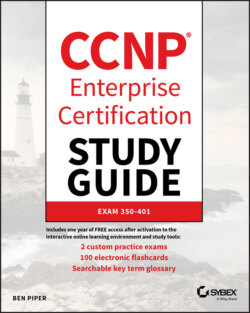Читать книгу CCNP Enterprise Certification Study Guide: Implementing and Operating Cisco Enterprise Network Core Technologies - Ben Piper, David Higby Clinton - Страница 32
The MAC Address Table
ОглавлениеAlthough switches eliminate collision domains by offering full-duplex communication, they still waste bandwidth by flooding traffic to nodes that don't need it. To mitigate flooding, switches implement a form of routing. When a switch receives a frame on an interface, it records the ingress interface and source MAC address in its MAC address table. Subsequently, when a switch receives a frame destined for that same MAC address, it queries the MAC address table, which returns the interface number. The switch then forwards the frame only out of that interface, rather than flooding it.
The MAC address table is stored in a type of memory called content-addressable memory (CAM). CAM is often used as a synonym for the MAC address table. The CAM takes a MAC address and VLAN as input and returns an interface name and number as the output. CAM provides faster read times than RAM.
SW3#show mac address-table dynamic Mac Address Table ------------------------------------------- Vlan Mac Address Type Ports ---- ----------- -------- ----- 1 0c3c.8a00.5e02 DYNAMIC Gi0/2 1 0c3c.8ad7.9101 DYNAMIC Gi0/2 1 0c3c.8afd.c101 DYNAMIC Gi0/1 1 0c3c.8afd.c102 DYNAMIC Gi0/2 10 0c3c.8ad7.800a DYNAMIC Gi0/0 20 0c3c.8ad7.8014 DYNAMIC Gi0/0 Total Mac Addresses for this criterion: 6
The use of the MAC address table changes the fundamental nature of MAC addresses. They no longer function as just names for identification, but also as addresses for location.
On the other hand, if a switch receives a frame for a MAC address that doesn't have a mapping in the MAC address table—called an unknown unicast—it reverts to its default behavior and floods the frame out of all other interfaces.
Unknown unicasts are more common than you might think. Entries in the MAC address table don't last forever. By default, a MAC address entry is deleted or ages out 300 seconds (5 minutes) after the switch last sees the traffic from the MAC address. Note that aging time is not based on when the entry was created.
SW3#show mac address-table aging-time vlan 1 Global Aging Time: 300 Vlan Aging Time ---- ---------- 1 300
You can adjust the global aging time to between 10 and 1,000,000 seconds or disable aging by setting the aging time to 0.
SW3(config)#mac address-table aging-time ? <0-0> Enter 0 to disable aging <10-1000000> Aging time in seconds
You can also adjust the aging time on a per-VLAN basis.
SW3(config)#mac address-table aging-time 300 vlan ? <1-4094> VLAN id
Disabling aging might sound like a good idea, as it would prevent flooding, right? Not necessarily. The CAM has a finite amount of space, and once the MAC address table is full, the switch will flood traffic to every destination MAC not in the table.
The MAC address table mitigates flooding but doesn't eliminate it. The fundamental flooding behavior of Ethernet remains. To make matters worse, Ethernet implements a special MAC address called a broadcast address (FFFF.FFFF.FFFF). Frames sent to this address are flooded out of all ports. You can imagine the number of major outages that arose from this unwise decision!
The end result is that any node in a broadcast domain can send a frame to another node and the destination node will receive it. We may have added more cables and more devices, but the fundamental behavior of Ethernet hasn't changed in 50 years, as shown in Figure 1.4. When it comes to networking, history has a way of repeating itself.
Figure 1.4 Early Ethernet over a shared medium compared to Ethernet using a switch
